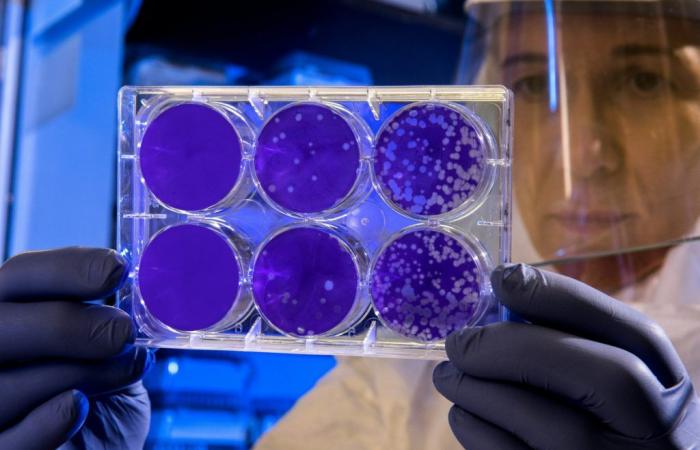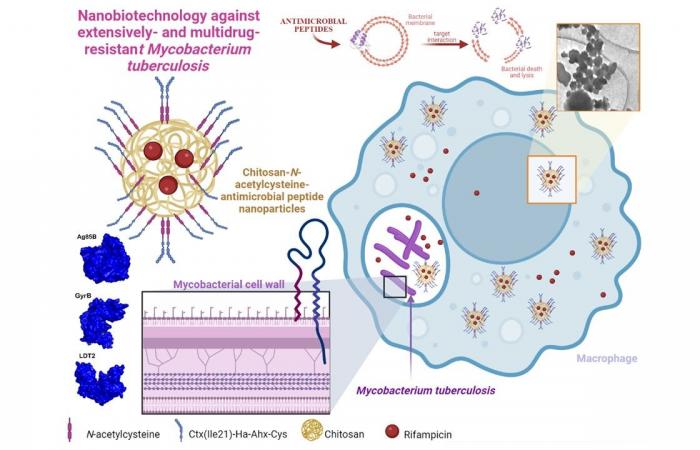Text: Julia Moióli | FAPESP Agency
Nanoparticles loaded with antibiotics and other antimicrobial compounds launch multiple attacks on the organism infected by the bacteria that cause most cases of tuberculosis. The low-cost technology developed by researchers at the Universidade Estadual Paulista (Unesp) was described in the scientific journal Carbohydrate Polymers. Test results in vitro suggest that this may be a treatment strategy capable of overcoming bacterial resistance.
The country with the highest number of reported tuberculosis cases in the Americas, Brazil registered around 78,000 infected people in 2022, according to the Ministry of Health, almost 5% more than in the previous year. In addition to the increased incidence, the disease transmitted by inhalation of the bacillus Mycobacterium tuberculosis, which affects the lung alveoli and causes inflammation in the tissues, is a concern due to the emergence of strains that are multi-resistant to available medications. Among the new strategies highlighted as promising by scientists around the world is the use of nanotechnology.
The Unesp study, financed by FAPESP (projects 20/16573-3, 22/09728-6 It is 23/01664-1), analyzed the antituberculosis activity of nanoparticles made from N-acetylcysteine-chitosan (a combination of a drug and a natural compound extracted from shrimp exoskeletons) functionalized with antimicrobial peptides – in this case, coming from the secretion of the skin of a species of frog found in the Brazilian Cerrado and loaded with the traditional drug rifampicin.
Study analyzed the activity of nanoparticles made of N-acetylcysteine and chitosan functionalized with antimicrobial peptides (image: Cesar Augusto Roque-Borda/biorender.com)
The results obtained indicate a potent inhibitory action of Mycobacterium tuberculosis and the reversal of drug resistance, without causing damage or injury to cells – the study was carried out with fibroblasts (connective tissue cells) and macrophages (immune cells) in vitro.
“Although rifampicin is already considered obsolete for certain strains of the bacteria that cause tuberculosis, in our study it was reused and optimized with antimicrobial peptides that have proven activity against the disease,” he says. Laura Maria Duran Gleriani Cousinfirst author of the work, scientific initiation scholarship holder and student on the undergraduate pharmacy course at Unesp.
“These peptides interact with several receptors in different locations of the bacteria, both in the membrane and in the periplasm [matriz localizada entre a membrana citoplasmática interior e a membrana bacterial exterior na bactéria]and showed the ability to revitalize rifampicin, which began to have even more activity within macrophages”, he adds Cesar Augusto Roque BordaPhD student in the Biosciences and Biotechnology Applied to Pharmacy Program at Unesp and co-supervisor of the study.
Perspectives
Conventional tuberculosis treatment requires the concomitant use of several types of antibiotics and lasts approximately six months. This time can be extended to up to two years, depending on the host’s response and the bacteria’s resistance. The researchers’ idea is that the developed system minimizes this period.
“Through this study, we already know that it is possible to insert a considerable concentration of antibiotics and peptides into macrophages, sufficient to enhance the treatment,” he says. Fernando Rogério Pavan, professor at the Faculty of Pharmaceutical Sciences at Unesp and coordinator of the study. “For the future, the expectation is to advance studies so that this type of nanotechnological system can also be used with other drugs, including slow-release ones. This way, the patient would not need to take the medication daily.”
The researchers’ next step will be to confirm in vivo the results obtained in cells and study the use of nanoparticles in other long-term diseases, which also require prolonged treatment periods.
The article Antimicrobial peptides grafted onto the surface of N-acetylcysteine-chitosan nanoparticles can revitalize drugs against clinical isolates of Mycobacterium tuberculosis can be read at: www.sciencedirect.com/science/article/abs/pii/S0144861723009141?via%3Dihub.







